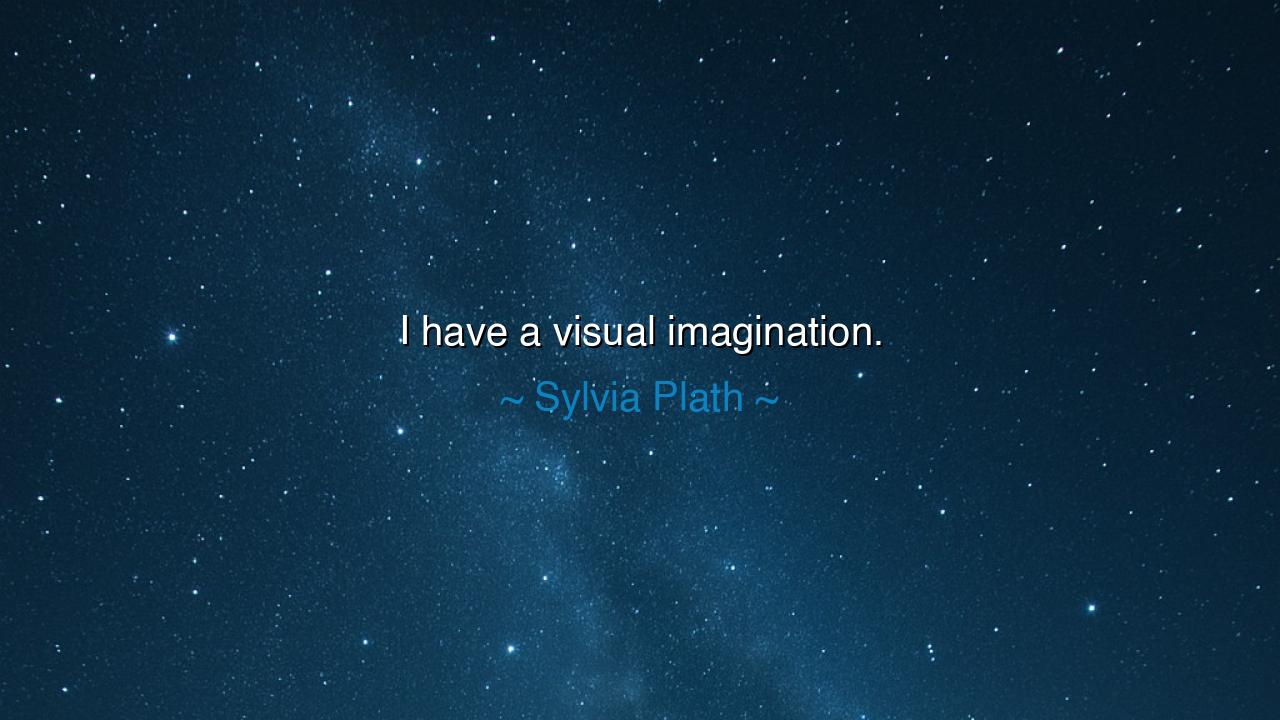
I have a visual imagination.






“I have a visual imagination.” Thus spoke Sylvia Plath, the poet whose words burned with the light and shadow of the soul. In this simple statement lies the key to her art, and to the art of all who see not only with the eyes, but with the mind’s vision — those for whom the world is not merely observed, but transformed into image, symbol, and dream. To have a visual imagination is to dwell between the seen and the unseen, to make of ordinary things a tapestry of meaning. For Plath, the physical world was never mute; it spoke, it shimmered, it mirrored the vast landscapes of her inner being.
The origin of this quote can be traced to Plath’s reflections on her own creative process. Unlike many writers who rely solely on abstraction or intellect, she drew her poetry from imagery, from the vivid pictures that arose before her mind’s eye. When she said, “I have a visual imagination,” she was not boasting, but confessing a truth — that her visions were both her gift and her torment. Her poems, such as Ariel, Tulips, and Lady Lazarus, are alive with visual power: the bright red of blood, the white of snow, the gleam of the moon upon glass. These are not mere ornaments of language; they are revelations of her soul’s theater.
For the visual imagination is not passive sight — it is creation. It is the power to see beyond the surface of life into the mythic and eternal. The ancient poets, too, spoke through vision: Homer saw gods upon the battlefield; Dante saw the very structure of Heaven and Hell; Blake beheld angels in the trees of London. Such imagination is not fantasy, but a form of truth that transcends reason. Plath stood in this same lineage — a modern seer in a fractured age. Her imagination turned the small moments of her life into epic struggle: a hospital room became a battlefield; a bee’s buzzing became a chorus of fate. Through vision, she made her suffering luminous.
And yet, this gift of vision carries a double edge. To see so deeply is also to feel too deeply. The visual imagination can illuminate, but it can also overwhelm. For those like Plath, the line between inner vision and external reality grows thin. The images that others admire for beauty may have been, for her, flames that burned too fiercely. In her journals, she spoke often of her mind’s eye as both a source of creation and of agony — her imagination could make the mundane magnificent, but it could also magnify despair. The poet’s vision, like a mirror of truth, reflects both the beauty and the terror of existence.
Consider the story of Vincent van Gogh, another soul possessed by a visual imagination that transcended the ordinary. To others, a field of wheat was but a field; to him, it was alive with golden light and restless motion, pulsing with the breath of the divine. His eyes saw what others could not — yet that very intensity drove him to the edge of madness. Like Plath, he painted from the fire within, transforming pain into color, anguish into light. Both remind us that those who see the world most vividly often bear its weight most heavily.
From this, a lesson emerges: to possess a visual imagination is to bear both a blessing and a burden. It is to walk as a bridge between worlds — to see the eternal shining through the transient. Yet for this vision to serve life rather than consume it, it must be guided by balance, by grounding in the tangible world. The visionary must learn not only to see, but to rest; not only to imagine, but to live. For imagination is like a great sea — it can carry the soul to new worlds, or drown it in its depths.
So, O seeker of truth, honor your visual imagination, but learn also to tend it. Feed it with nature, art, and silence; guard it from despair and excess. Let your visions uplift, not enslave. As Sylvia Plath teaches through her life and her luminous words, to see the world through the lens of imagination is to live twice — once in body, and once in vision. But remember: the light that shines so brightly must be tended with care, lest it burn itself out.
Thus, her simple declaration — “I have a visual imagination” — becomes not only a statement of creativity, but a timeless teaching. It tells us that imagination is the soul’s eye — the sacred gift that allows us to see beauty where others see dust, meaning where others see void. Cherish it, discipline it, and let it guide you toward truth. For in the end, those who truly see — not with the eyes, but with the imagination — awaken the hidden life of the world, and through their vision, help all humanity to see anew.






AAdministratorAdministrator
Welcome, honored guests. Please leave a comment, we will respond soon